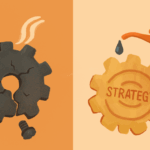As prospective students become more discerning, higher education institutions face a daunting challenge: How to stand out in an ever-expanding sea of media and messaging options? Gone are the days of relying on traditional marketing methods and superficial appeals to authenticity. Today, colleges and universities must embrace transformative shifts to resonate deeply with their target audience.
Embrace the chaos, or get left behind. Three shifts to break through the noise.
Higher ed brands must abandon conventional approaches, redefine authenticity and turn innovative strategies into a powerful advantage that positions them for success.

The New Marketing Landscape
Regardless of how many timeless truths exist in marketing, our much-changed and quickly evolving media landscape is no longer disputed. Marketing leaders are forced to compete in a category that’s in flux — within a culture that questions its value — and improve effectiveness amid media platforms that have not only changed the way we consume content but also caused exponential growth in choice.
These shifts have led to what some have called the New Communications Economy: a moment defined when increasingly more consumer time is spent outside of traditional advertising. Within our category, prospective students spend more time using media.
Their attention is divided across more media in ways that make it harder to achieve reach and resonance. Community and culture are distributed across multiple producers and formats, making a brand’s voice less dominant. Prospective students aren’t just evaluating their current experience with an institution, they are bringing with them experiences outside of our industry and increasingly higher expectations.
Although these changes create challenges, opportunities emerge for those who are willing to redefine and shift how we think about building higher ed brands. In the famous words of Merry Baskin, “Like a shark, brands must move forward or die.”
So how do we move forward? Below are three brand shifts for better brand thinking.
1. Institutional Barriers → Big Ideas
To influence the perceived value of higher education, secure real outcomes in the minds of prospective students and stake a claim in the marketplace, institutions must rally around big brand ideas that build across the institutions and do not break down across organizational barriers.
SimpsonScarborough’s most recent CMO Study showed there’s been a small increase in institutions moving to a centralized marketing model. Historically, higher ed brands have been managed across disparate marketing and comms teams, creating layers of messages, incongruent creative and a multitude of vendors extending the meaning-making devices needed to create brand cohesion.
Moving forward, we must shift our thinking from a siloed marketing view to brand campaigns that are big enough to support giving, advancement and the College of Arts and Sciences. To borrow from Gareth Kay, “We need to think about creating strategies that have an enthusiasm bigger than the brand or the category.”
2. Authenticity → Ambition
When it comes to delivering on a big brand idea or the creative strategy meant to express a brand, inevitably the advice is to be authentic. For Gen Z, Alpha and the rest, authenticity is the key to consumer trust. What often underpins this advice is that brands somehow take on human-like qualities and that consumers want human-like relationships with brands. And yet, in this drive to deliver authenticity, we’ve forgotten that audiences don’t want a relationship, they want relevance. Brands are artificial constructions and at their most basic, provide a specific function.
To build and shape higher ed brands, our marketing must shift from seeking authenticity to reflecting our brands’ ambitions and how those ambitions create distinction in the marketplace. As Stephen King wrote: “Marketing companies today… recognize that rapid response in the marketplace needs to be matched with a clear strategic vision.”
As higher education’s value continues to be questioned, I cannot think of a better moment where clarity in vision must translate to a clear value proposition. So, if we must use the term “authentic,” then perhaps we should frame it as being authentic to our institution’s ambitions.
If higher ed is increasingly feeling the competitive pressure from outside of our subsector, then our marketing must shift consumer priorities. In other words, we must shift our thinking in a way that defines our ambition and, in that definition, show how that benefits future learners.
3. Enrollment Funnels → Brand Experience
As martech continues to layer one software solution on top of the other and short-termism permeates higher ed’s approach to marketing, our reliance on optimizing funnels versus delivering compelling brand experiences prevails.
When we view the prospective student journey as a series of actions meant only to optimize until the desired action takes place — an action that may have no bearing on actual enrollment outcomes — we miss out on the human element of not only the student but also the decision-making process.
When the experience is viewed through a browser or software (I am an advocate of over-investing in CRM, by the way!), I fear that we miss the emotions that lead to a decision throughout various touchpoints. It has been well documented that emotion is a driver of brand choice, so our ability to unlock emotional responses and purposeful moments along the customer journey can give higher ed marketers that competitive advantage.
We must shift our view from the assembly line of optimizations. Instead, we should focus on the holistic experiences students have with the brand and how marketers can leverage emotion to create a unifying approach to designing brand experiences.
There’s a saying that individuals will stay the course until the pain of staying the same is greater than the pain of changing. We are at an inflection point where we must begin to shift our thinking to account for the category, culture and consumer changes we’ve seen emerge. These three shifts may just provide those solid series of steps to weather the storm.
Newsletter Sign up!
Stay current in digital strategy, brand amplification, design thinking and more.



